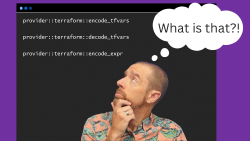

This post was sponsored by HashiCorp, see the bottom for more details
Before we get into the announcements and the event, I want to pause for a moment and just acknowledge how amazing everyone was at the conference. Before the keynote each day, the HashiCorp MCs explained the code of conduct for the event, ending with above all be kind. Without exception, the people I met at the conference were overwhelmingly kind, generous with their time, and excited to engage with fellow attendees. I’ve been to plenty of conferences in the past where I felt awkward; unsure of where to be and who to talk to. At no point did I feel this way at HashiConf. I couldn’t walk more than ten feet of the expo floor without landing in a conversation with friends both old and new. The HashiConf attendees and the larger HashiCorp community are incredibly warm, inviting, and above all kind.
Alright, alright, alright. That’s enough of the mushy stuff, what about the tech? I won’t exhaust you by listing out each and every update, instead I’d like to focus on a couple key trends of the conference. Namely, the increasing focus on HashiCorp Cloud Platform (HCP) and the evolving role of the platform team.
Over the last few years, HashiCorp has rolled out SaaS offerings around their product portfolio starting with Terraform Cloud and expanding to HCP Consul, Vault, and Packer. Each offering is still based on the open-source version of the offering, but helps to offload some of the administrative burden involved in running the solution in production. In particular, both Consul and Vault require a significant amount of effort to deploy, upgrade, and maintain the solution, which represents undifferentiated heavy lifting for your operations team. HCP aims to manage those tasks for you, freeing you and your team up to leverage the features of each solution without having to worry about its care and feeding. You know, Software as a Service!
The keynote announcements continued this trend with the release of HCP Vault on Azure in Beta, HCP Waypoint in Beta, and HCP Boundary in GA. I’m really excited to see HCP Vault coming to Azure and I’m curious to see what new DR and Performance topologies are supported as the service becomes generally available. I was surprised and more than a little chuffed to see HCP Boundary go GA so swiftly. There’s really no reason for you to manage the control plane of Boundary yourself, so why not let HashiCorp do that heavy lifting for you? For a product that is only a couple years old, Boundary has come sprinting out the gate and I’m excited to see it approach a 1.0 release.
The other big idea is around the platform team as an operating model. Based on the HashiCorp State of Cloud Strategy report, a majority of organizations are using multicloud and building a platform team to support their DevOps teams by providing a stable platform to deploy on, along with guidance and templates that enable developer self-service. During the Keynote, Armon made sure to point out this emerging trend, but I don’t think he made it completely clear how platform teams and multicloud are going to impact tool selection.
The reality of hybrid and multicloud means most platform teams are going to be supporting more than one cloud provider. As part of their tool selection and workflow design, those platform teams are going to be on the lookout for solutions that support a consistent look and feel across multiple cloud providers. We also have the tightening of economic purse strings across the world, leading to a slowdown in hiring and a push for automation - aka doing more with less. I’ve noticed these trends on my own, as have several other analysts and industry pundits. It was gratifying to see during the keynote that HashiCorp also understands the problem space and they are focusing on developing features in their products to assist the platform team with multicloud challenges.
In my post leading up to HashiConf Global, I said that I was going to be spending my time watching the hallway sessions and hanging with people in the hallway track. And I did exactly that. Unfortunately the hallway sessions were not recorded, so I can’t share them with you. But I did have some favorites, and I’d like to point you to the folks behind those sessions.
Bryan Krausen gave a great talk about what he’s learned about Vault from over five years of consulting. Turns out a lot of folks are using the root token for everyday operations. Stop that! Definitely check out Bryan’s content on Udemy if you want to learn a ton about Vault. Maybe even buy the book he co-authored!
Steven Ma from Microsoft gave us an update about what’s new with Azure Terrafy. While the name hasn’t yet changed - although they are planning to do so - they released 0.8.0 of the tool just in time for the conference. A couple big highlights for me are the addition of a filter to pull in resources across an entire subscription and improved cross resource dependency resolution. They’ve also got an aggressive roadmap full of awesome features. If you have an opinion on what you’d like to see next, join the Azure Terraform community and let them know!
While I don’t know a ton about Nomad, I’ve always been curious about how it might stack up against Kubernetes in the long term. Matt Butcher from Fermyon talked about how they gave up trying to shoehorn WebAssembly programs into Kubernetes and instead chose to use Nomad with a custom driver. They have a blog post that lays things out quite nicely if you want to know more.
You might be wondering if Mitchell Hashimoto actually hung out in the hallway track as promised? I assure you that he did. Unfortunately I was on my way to deliver my breakout session when I saw him, but I know that he was hanging out by the hallway track area for a couple hours, graciously speaking to anyone who wanted to meet him and taking in the excellent energy of the conference.
And that brings me nicely back to my original point about HashiConf. From the Founders to the CEO to employees at all levels of HashiCorp, everyone I met was friendly and engaging. No one was putting on airs or acting aloof. That positive energy was palpable and extended out to the speakers and attendees. For me, that is the true value of attending a conference, not the technical sessions or the big keynote announcements. It is the opportunity to connect with the community; to meet new friends; to have interesting conversations. By that measure, HashiConf Global was a resounding success and I can’t wait for next year!
Sponsorship – This post was sponsored by HashiCorp. Although I received compensation, they did not tell me what I could/couldn’t write about. All opinions and thoughts remain mine. Big thanks to the fine folks at HashiCorp for helping me keep the lights on!
Using Provider Defined Functions in Terraform
July 18, 2024

Variable Validation Improvements in Terraform 1.9
July 8, 2024

July 6, 2024
